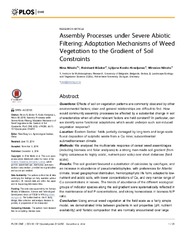Приказ основних података о документу
Assembly Processes under Severe Abiotic Filtering: Adaptation Mechanisms of Weed Vegetation to the Gradient of Soil Constraints
| dc.creator | Nikolić, Nina | |
| dc.creator | Boecker, Reinhard | |
| dc.creator | Kostić Kravljanac, Ljiljana | |
| dc.creator | Nikolic, Miroslav | |
| dc.date.accessioned | 2022-04-05T14:49:21Z | |
| dc.date.available | 2022-04-05T14:49:21Z | |
| dc.date.issued | 2014 | |
| dc.identifier.issn | 1932-6203 | |
| dc.identifier.uri | http://rimsi.imsi.bg.ac.rs/handle/123456789/766 | |
| dc.description.abstract | Questions: Effects of soil on vegetation patterns are commonly obscured by other environmental factors; clear and general relationships are difficult to find. How would community assembly processes be affected by a substantial change in soil characteristics when all other relevant factors are held constant? In particular, can we identify some functional adaptations which would underpin such soil-induced vegetation response? Location: Eastern Serbia: fields partially damaged by long-term and large-scale fluvial deposition of sulphidic waste from a Cu mine; subcontinental/submediterranean climate. Methods: We analysed the multivariate response of cereal weed assemblages (including biomass and foliar analyses) to a strong man-made soil gradient (from highly calcareous to highly acidic, nutrient-poor soils) over short distances (field scale). Results: The soil gradient favoured a substitution of calcicoles by calcifuges, and an increase in abundance of pseudometallophytes, with preferences for Atlantic climate, broad geographical distribution, hemicryptophytic life form, adapted to low-nutrient and acidic soils, with lower concentrations of Ca, and very narrow range of Cu concentrations in leaves. The trends of abundance of the different ecological groups of indicator species along the soil gradient were systematically reflected in the maintenance of leaf P concentrations, and strong homeostasis in biomass N:P ratio. Conclusion: Using annual weed vegetation at the field scale as a fairly simple model, we demonstrated links between gradients in soil properties (pH, nutrient availability) and floristic composition that are normally encountered over large geographic distances. We showed that leaf nutrient status, in particular the maintenance of leaf P concentrations and strong homeostasis of biomass N:P ratio, underpinned a clear functional response of vegetation to mineral stress. These findings can help to understand assembly processes leading to unusual, novel combinations of species which are typically observed as a consequence of strong environmental filtering, as for instance on sites affected by industrial activities. | en |
| dc.publisher | Public Library Science, San Francisco | |
| dc.relation | info:eu-repo/grantAgreement/MESTD/Basic Research (BR or ON)/173028/RS// | |
| dc.rights | openAccess | |
| dc.rights.uri | https://creativecommons.org/licenses/by/4.0/ | |
| dc.source | PLoS One | |
| dc.subject | Weed Vegetation | |
| dc.title | Assembly Processes under Severe Abiotic Filtering: Adaptation Mechanisms of Weed Vegetation to the Gradient of Soil Constraints | en |
| dc.type | article | |
| dc.rights.license | BY | |
| dc.citation.issue | 12 | |
| dc.citation.other | 9(12): - | |
| dc.citation.rank | M21 | |
| dc.citation.volume | 9 | |
| dc.identifier.doi | 10.1371/journal.pone.0114290 | |
| dc.identifier.fulltext | http://rimsi.imsi.bg.ac.rs/bitstream/id/933/763.pdf | |
| dc.identifier.pmid | 25474688 | |
| dc.identifier.scopus | 2-s2.0-84916225992 | |
| dc.identifier.wos | 000346382500011 | |
| dc.type.version | publishedVersion |

